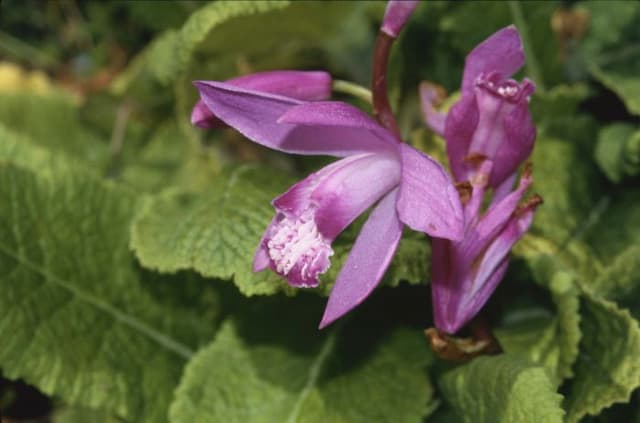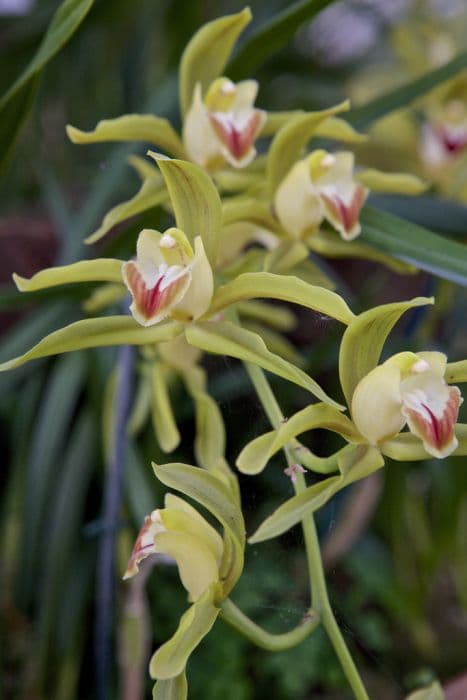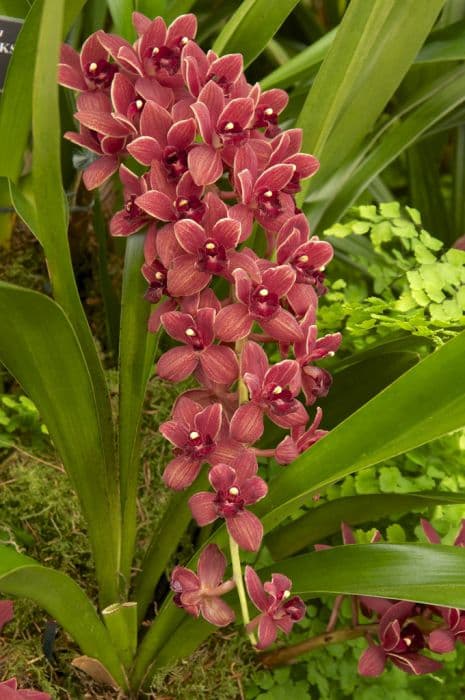Jewel Orchid Ludisia discolor

ABOUT
The Ludisia discolor, commonly known as the Jewel Orchid, is an alluring plant celebrated for its distinctive foliage rather than its flowers. This orchid is unlike the more commonly known species with flashy flowers. The main attraction of the Jewel Orchid is its leaves, which have a velvety texture and a unique coloring that sets it apart from other houseplants. The leaves are deep green but are veined with stunning colors that can appear to range from pink to a striking gold or silver. The appearance of the veins can give the leaves a shimmering quality when light reflects off of them, hence the name "Jewel." Some may describe the veining pattern as pinstriped, which gives the leaves an elegant and intricate look. The flowers of the Jewel Orchid, although not as prominent as its foliage, are nonetheless attractive. They grow on a spike and are typically small and white with yellow centers or accents. In contrast to the leaves, the flowers are subtle and are not the main reason that plant enthusiasts cultivate this particular orchid. The overall look of the Jewel Orchid is one of lushness and ornate detail, making this plant a favorite for those seeking to add a touch of understated elegance to their indoor plant collection.
About this plant
 Names
NamesFamily
Orchidaceae
Synonyms
Jewel Orchid, Black Jewel Orchid
Common names
Anoectochilus dawsonianus, Anoectochilus grandiflorus, Dossinia marmorata var. dayii, Dossinia marmorata var. nuda, Gonogona marmorata, Haemaria discolor, Ludisia dawsoniana.
 Toxicity
ToxicityTo humans
Jewel orchid is generally considered non-toxic to humans. Ingesting any part of this plant is unlikely to cause serious harm or symptoms of poisoning. However, as with any plant material, individual allergies or reactions are always possible, and caution should be exercised.
To pets
Jewel orchid is not known to be toxic to pets. It does not typically cause any adverse symptoms when ingested by animals such as cats and dogs. However, it's always best to prevent pets from chewing on houseplants as a general precaution.
 Characteristics
CharacteristicsLife cycle
Perennials
Foliage type
Evergreen
Color of leaves
Mixed
Flower color
White
Height
6-12 inches (15-30 cm)
Spread
12-24 inches (30-60 cm)
Plant type
Herb
Hardiness zones
11
Native area
Southeast Asia
Benefits
 General Benefits
General Benefits- Easy to Grow: Ludisia discolor, commonly known as the Jewel Orchid, is relatively easy to care for compared to other orchids, making it suitable for beginners.
- Aesthetic Appeal: With its striking dark green leaves with red veins, it adds a unique visual interest to any indoor plant collection.
- Low Light Tolerance: Unlike many other orchids, the Jewel Orchid can thrive in low light conditions, making it more versatile for indoor spaces.
- Humidity Tolerance: It can tolerate a range of humidity levels which is beneficial for environments that are not strictly controlled for humidity.
- Compact Size: It remains small to medium in size, so it doesn’t require a lot of space and can be easily displayed.
- Pet-Friendly: This plant is non-toxic to cats and dogs, making it a safe choice for pet owners.
 Medical Properties
Medical PropertiesThis plant is not used for medical purposes.
 Air-purifying Qualities
Air-purifying QualitiesThis plant is not specifically known for air purifying qualities.
 Other Uses
Other Uses- Ludisia discolor, commonly known as the Jewel Orchid, is often used in terrariums for its attractive foliage and ability to thrive in humid, low-light environments.
- The plant can serve as a living mulch in indoor gardens, retaining soil moisture and preventing weed growth around larger plants.
- Jewel Orchids are sometimes used in educational settings as an example of plants with unique leaf pigmentation, ideal for lessons on botany and horticulture.
- These orchids can be used in floral art and arrangements, where their leaves add a vivid contrast to traditional greenery.
- In aquascaping, especially in paludarium setups, Jewel Orchids can be incorporated as a part of the emergent vegetation.
- They might be included in miniature gardens or fairy gardens due to their small size and ornamental appearance.
- Jewel Orchids can be used as companion plants in orchid collections to create diverse displays that highlight different textures and colors.
- Photographers sometimes utilize Ludisia discolor as a photogenic subject or as a backdrop for macro photography, due to their striking leaves.
- The plant can act as an indicator of high humidity in an environment, as it thrives under such conditions, signaling when other humidity-loving plants might need attention.
- As a low-light tolerant plant, Ludisia discolor can be used to add greenery to darker areas of a home or office where other plants might not survive.
Interesting Facts
 Feng Shui
Feng ShuiThe Ludisia, also known as the jewel orchid, is not commonly referenced in traditional Feng Shui practice.
 Zodiac Sign Compitability
Zodiac Sign CompitabilityThe jewel orchid is not used in astrology practice.
 Plant Symbolism
Plant Symbolism- Elegance: Ludisia discolor, commonly known as the Jewel Orchid, is often associated with sophistication and elegance due to its velvety, dark green leaves with striking pinstripes. This characteristic makes it a symbol of grace and refined beauty.
- Rarity: As a unique and less common orchid variety, the Jewel Orchid symbolizes rarity and preciousness, much like a rare gemstone.
- Wealth: The Jewel Orchid's shimmering foliage resembles opulent jewels, making it a symbol of wealth and prosperity.
- Inner beauty: Despite bearing less conspicuous flowers compared to other orchids, the Jewel Orchid's modest blooms coupled with its gorgeous leaves stands for inner beauty and the importance of subtlety.
- Mystery: The dark, almost mystical appearance of the Jewel Orchid leaves lends it a sense of mystery and intrigue, symbolizing the unknown or the unexplored.
 Water
WaterThe Jewel Orchid should be watered when the top inch of soil feels dry to the touch, typically every 1 to 2 weeks depending on the humidity and temperature of its environment. Use room temperature water, and thoroughly soak the soil until water runs freely from the drainage holes, but always avoid letting the plant sit in standing water. During the active growing season in spring and summer, increase watering slightly, but reduce it in the dormant fall and winter months. A good guideline is to provide approximately 8 to 16 ounces of water every week or two, adjusting as needed for the plant's conditions.
 Light
LightThe Jewel Orchid thrives in low to medium light conditions, out of direct sunlight. A north-facing windowsill or a spot that receives filtered light through a sheer curtain is ideal. Direct sunlight can scorch the leaves, so ensure the plant is placed where the light is diffused for optimal growth.
 Temperature
TemperatureJewel Orchids prefer temperatures between 60 to 80 degrees Fahrenheit and should not be exposed to temperatures below 50 degrees Fahrenheit as they can be damaged by the cold. The ideal temperature range for the Jewel Orchid should be kept consistent with minimal fluctuations to promote healthy growth.
 Pruning
PruningPrune the Jewel Orchid to remove any yellow or damaged leaves and to encourage a fuller plant shape. This is typically done in the spring, but can be done at any time of year when necessary. Periodic pruning also helps to rejuvenate the plant and stimulate new growth. Pruning is not required frequently, only as needed to maintain the desired appearance of the plant.
 Cleaning
CleaningAs needed
 Soil
SoilJewel Orchid thrives best in a well-draining soil mix consisting of sphagnum peat moss, perlite, and pine bark fines in equal parts. The ideal soil pH for Ludisia discolor should range from 5.5 to 6.5, slightly acidic to match their natural understory habitat.
 Repotting
RepottingJewel Orchids should be repotted every 1-2 years or when they outgrow their pots, as they have a relatively small root system. It's best to do this in spring when the plant is entering its active growth phase.
 Humidity & Misting
Humidity & MistingJewel Orchid prefers high humidity levels, ideally between 60-80%. It's crucial to maintain a consistently humid environment without letting the foliage remain wet for extended periods to prevent fungal issues.
 Suitable locations
Suitable locationsIndoor
Place Jewel Orchid in diffuse light, keep soil moist, and ensure high humidity.
Outdoor
Grow Jewel Orchid in warm, shaded, humid areas.
Hardiness zone
11-12 USDA
 Life cycle
Life cycleLudisia discolor, or Jewel Orchid, begins its life cycle when a seed germinates, often in a symbiotic relationship with a fungus that helps it absorb nutrients. After germination, a tiny protocorm develops, which then forms its first roots and leaves. The plant grows vegetatively, producing distinctive veined leaves, and it can spread by forming new growth points or keikis at the nodes along its creeping rhizomes. When mature and under proper conditions, Ludisia discolor will produce a flower spike with small white flowers, usually during winter months. After pollination, potentially with the help of insects, the flowers will develop into seed capsules containing thousands of minute seeds, which are then dispersed, primarily by wind, completing the life cycle. Throughout its life, the plant will continue to grow and can be propagated vegetatively by division or from leaf cuttings.
 Propogation
PropogationPropogation time
Spring-Early Summer
The most popular method of propagation for the Jewel Orchid, or Ludisia discolor, is through division. This is often done in spring right before the growing season starts or after the plant has flowered. To propagate by division, gently remove the plant from its pot and separate the rhizomes, ensuring each section has at least one growth point or a couple of leaves. These divisions can then be potted up individually in a mix suitable for orchids, which typically includes fir bark, perlite, and peat moss, with the rhizomes placed just at the surface. The new pots should be kept in warm, humid conditions away from direct sunlight, and they should be watered sparingly until new growth indicates the divisions have established.









